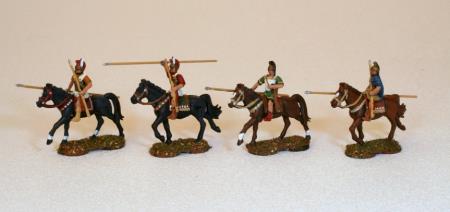
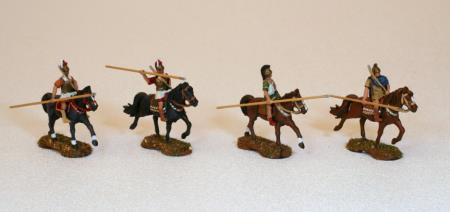
 |
 |
The photo to the right are Allied Greek Cavalryfrom Hät's Macedonian Army.Click on the photo to see a larger version.This inexpensive ($7.50) box contains 60 foot and 12 mounted figures - an excellent value.The range of unit types and poses for this price is unequaled by metals miniatures.Additionally, Hät and many other quality manufacturers (e.g. ESCI, Italeri, Zvedzda, IMEX, Stretlets)make many ancient figures to ally or oppose this army.See Plastic Soldier Review for many photos and write ups on all the different figures.
The fancy-looking commanders (two black horses to left side) have fancybronze muscle cuirasses and bronze helmets adorned with white feathers.These look much like the style of helmet portrayed in the Oliver Stone movie Alexander.The two riders to the right have less expensive linen "linothorax" armor.of linen and thorax because it covered the midsection or thorax.This classical Greek armor often has "pteruges" or feathers which coveredthe hips, groin, and upper legs.These cavalry have smaller spears than the Alexandrian Companion cavalry.
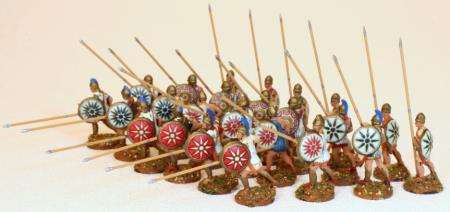 |
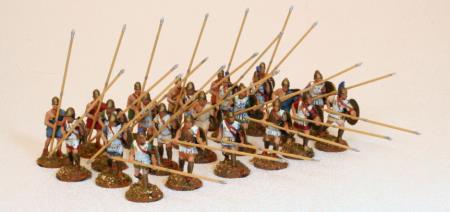 |
The phalangists are shown here with the long sarissa pike.Following Alexander the Great, the pikes of the Successor phalanxeswere often 5 meters in length.Here they are shown as the shorter Alexandrian length of about4 meters.It is postulated these extremely long spears were disassembled after battle,and thus I have painted a metallic joint about halfway up the spear.
It is probable that the entire phalanx sported one shield design.I have used 6 different designs from Little Big Men Studiospartly because I love the designs, and partlybecause it helps me sort the soldiers.This phalanx has 24 soldiers, but if you want to make 2 smallerphalanxes of 12 soldiers each, you can simple sort by shield designto get similar poses.
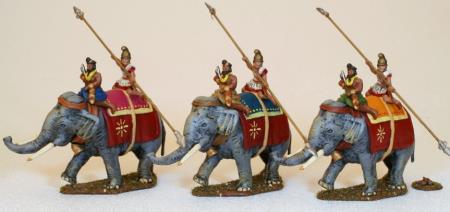 |
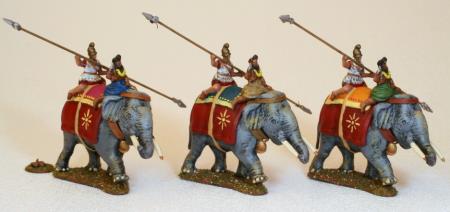 |
The elephants are painted with some rather exotic and festive blankets.Since the driver appears Indian in nature, I postulated that he was hired from Indiaand thus the blankets would appear eastern in nature.Hence I painted the topmost blanket with exotic saffron, azure, and cyan colorings.The underblanket is a more uniform red color with a Macedonian eight-pointed star.The lone warrior on the back appears Greek in armorand carries a rather long and heavy 4 meter pike.Despite the excellence of these models, I cannot fathom the elephants doing much damageother than perhaps trampling people.It still seems rather easy for bowmen to take out the crew on these beasts.
In order to prevent too much similarity, I modified the elephant heads so theyall tilt in slightly different directions. To do this I had to cut the rubbery plasticassembly keys and then mount slightly tilted.I used 30 minute epoxy which seems to form a strong adhesive joint.I also drilled some holes in the base of the head and the body to make surethe epoxy had some places to flow and grab tightly, and not just a flat smooth surface.
Most paints used on these figures are Reaper Master Series paints.I use Reaper, Vallejo, Foundry, and many other paints.I like Reaper because of the wide range of colors, the eye-dropper squeezey bottle witha mixing pellet, and the thin fine nature of the paints.
Well, that is all for now. Even with the speed painting, I am happy withthe results.The Alexandrian Army box is now done, and it is time to work on an opponentfor battle. Will it be Darius and the Persians at the Battle of Issus?Or will it be King Porus (Raja Puru) and the Indians at the Battle of Hydaspes?Thanks for reading about my miniatures. More links are at the bottom of the page.